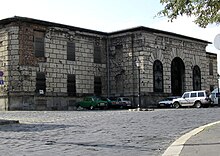Ku Honved Ministry

The ku Honvédministerium ( German “Royal Hungarian Ministry of Defense” ) with its seat in Budapest was responsible for the financing, organization and administration of the military units of the Royal Hungarian Landwehr (Hungarian: Magyar Királyi Honvédség.) Established from 1868 in the Transleithan Empire of the Austro-Hungarian Empire ) and the affiliated Croatian-Slavonian Landwehr . The Honvéd Ministry existed from 1868 until the collapse of the common army in early November 1918.
It was one of three armed forces ministries of the dual monarchy that functioned formally independently of each other during peacetime. The other two ministries (based in Vienna ) were:
- the kuk war ministry - responsible for the joint army and navy
- the Imperial and Royal Ministry of Defense - responsible for the Imperial and Royal Landwehr
Framework
After the lost war with Prussia (which Prussia had started), Emperor Franz Joseph I was forced in 1866/1867 to grant the Kingdom of Hungary , which had remained in passive resistance since the failed secession in 1849, partial sovereignty and equal rights with Austria with the so-called Austro-Hungarian compromise . For this purpose, the Austrian Empire (with Hungary as a part) , which had been uniformly run until then, had to be constitutionally converted into the so-called “dual monarchy”.
One of Hungary's demands was for its own armed forces. The compromise with the crown resulted in the right of both halves of the empire to set up their own territorial forces in addition to the still existing (joint) army from 1867: In Transleithanien the ku Landwehr (Hungarian: Királyi Honvédség , also in German, in contrast to the Austrian Landwehr, often referred to as Honvéd) built up, in Cisleithanien according to her the kk Landwehr .
Although the common army formed the bulk of the total armed power, there was no common defense law for both halves of the empire. These had reserved autonomy in recruiting in 1867 .
organization
budget
From 1868 three de jure independent army bodies existed side by side in Austria-Hungary, of which the common army was by far the largest institution. In 1896, for example, 140.2 million guilders were budgeted for the army, 15.7 million for the Landwehr and 14.7 million for the Honvéd (1895). Due to the significantly lower number of recruits in the Landwehr, however, it was not automatically worse off from a budgetary point of view: the army budget also included costs for building fortifications, for example; the Landwehr, however, could concentrate on training and equipment.
Commander in chief
Until July 1914, Emperor Franz Joseph I himself held the “ supreme command ”; at the beginning of the war he appointed General of the Infantry Archduke Friedrich von Österreich-Teschen as Army Commander in Chief, to whom all land forces in Austria-Hungary were subordinate. On December 2, 1916, Karl I./IV. the ah. Supreme command itself and kept it until the collapse of the common army in early November 1918.
Seat
The Royal Honvéd Ministry last had its seat in a building with a splendid facade, erected between 1879 and 1881, which was located on Szent György tér in the Castle District of Budapest . On December 30, 1916, the newly crowned King Charles IV. Took place on St. Georgs-Platz in front of the Honvéd Ministry on the coronation hill, which had been specially built for this purpose. In the Battle of Budapest in the winter of 1944/45, the Honved Ministry building was badly damaged and later demolished. A museum on the history of the Hungarian army is now set up on the preserved ground floor of the building.
literature
- kuk war ministry “Dislocation and division of the kuk army, kuk navy, kk landwehr and ku landwehr” in: Seidel's small army scheme - published by Seidel & Sohn Vienna 1914
Individual evidence
- ^ Austro-Hungarian monarchy. Army and Navy in: Meyers Konversations-Lexikon , Volume 13, Bibliographisches Institut, Leipzig and Vienna 1896, p. 302 f.


